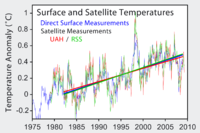
Photo from wikipedia
Measurements of brightness temperatures from Advanced Microwave Sounding Unit-A (AMSU-A) temperature sounding instruments onboard NOAA Polarorbiting Operational Environmental Satellites (POES) have been extensively used for studying atmospheric temperature trends over… Click to show full abstract
Measurements of brightness temperatures from Advanced Microwave Sounding Unit-A (AMSU-A) temperature sounding instruments onboard NOAA Polarorbiting Operational Environmental Satellites (POES) have been extensively used for studying atmospheric temperature trends over the past several decades. Intersensor biases, orbital drifts and diurnal variations of atmospheric and surface temperatures must be considered before using a merged long-term time series of AMSU-A measurements from NOAA-15, -18, -19 and MetOp-A.We study the impacts of the orbital drift and orbital differences of local equator crossing times (LECTs) on temperature trends derivable from AMSU-A using near-nadir observations from NOAA-15, NOAA-18, NOAA-19, and MetOp-A during 1998–2014 over the Amazon rainforest. The double difference method is firstly applied to estimation of inter-sensor biases between any two satellites during their overlapping time period. The inter-calibrated observations are then used to generate a monthly mean diurnal cycle of brightness temperature for each AMSU-A channel. A diurnal correction is finally applied each channel to obtain AMSU-A data valid at the same local time. Impacts of the inter-sensor bias correction and diurnal correction on the AMSU-A derived long-term atmospheric temperature trends are separately quantified and compared with those derived from original data. It is shown that the orbital drift and differences of LECTamong different POESs induce a large uncertainty in AMSU-A derived long-term warming/cooling trends. After applying an inter-sensor bias correction and a diurnal correction, the warming trends at different local times, which are approximately the same, are smaller by half than the trends derived without applying these corrections.
Journal Title: Frontiers of Earth Science
Year Published: 2017
Link to full text (if available)
Share on Social Media: Sign Up to like & get
recommendations!